
- When issues with truancy become apparent, districts were encouraged to continue home visits as long as safety protocols are followed.
- Julian Tackett, commissioner of the Kentucky High School Athletic Association, provided an overview of the Healthy at Sports guidance.
By Jacob Perkins
Jacob.perkins@education.ky.gov
The Kentucky Department of Education’s (KDE) Commissioner’s Parents Advisory Council held a virtual meeting on Sept. 9 to offer feedback on student participation during non-traditional instruction (NTI) and the department’s reopening guidance on truancy.
On Sept. 8, KDE released “COVID-19 Considerations for Reopening Schools: Truancy and Compulsory Attendance.” The guidance notes that compulsory attendance requirements remain in force during the pandemic.
Kentucky’s school districts will handle truancy in much the same manner as they have in the past, said Matt Ross, policy adviser in KDE’s Office of Finance and Operations. The difference for the 2020-2021 school year is that districts will be counting participation rather than attendance.
“During this period of sustained remote learning, we feel it’s very important to try and engage all students and we need as many students participating as possible,” said Ross.
At its July 10 meeting, the Kentucky Board of Education approved an amendment to 702 KAR 7:125, which gives school districts the ability to provide and receive funding for a variety of instructional delivery models to meet the needs of their students and communities during the 2020-2021 school year.
The amendment temporarily suspends the collection of student attendance data for funding purposes. In its place, it established a process for collecting data on student participation and requires that districts report student participation rates to KDE. The department will report the data to the Legislative Research Commission, as well as share it publicly through the KDE website.
Districts are required to collect and enter student participation information in Infinite Campus. Participation for in-person instruction can be counted by a student being present in the classroom, and for remote learning, through interactions with teachers, Ross said.
“If a student is not participating … then they should be held to the same standard and considered truant,” said Ross. “Districts should work with students and families to engage students and promote participation.”
When issues with truancy become apparent, Ross encouraged districts to continue home visits as long as COVID-19 safety protocols are followed.
Council member Judith Bradley questioned if Admissions and Release Committees (ARCs) will need to address participation in a student’s Individual Education Program (IEP). Participation for a student with disabilities may look different and require different types of interactions, she said.
David Cook, division director of KDE’s Office of Continuous Improvement and Support, said every district has submitted an NTI application for this fall. Within the application, districts were required to state how NTI is being incorporated into the ARCs and a student’s IEP.
Cook said daily participation for students learning through NTI may be in real-time during the school day or at times outside of typical school hours and include at least one of the following:
- One-on-one video communication or phone calls between teacher and student or one-on-one communication with a parent or guardian of smaller children or students with special needs;
- Group video communication or phone calls between the teacher and the whole class or between a teacher and smaller groups of students within a class;
- Student time logged into a learning management software system completing assignments; and
- Submission of paper-based assignments for students in a non-digital NTI setting.
Given the multiple ways to determine participation, Bradley said she is concerned with the additional burden placed on educators.
Cook said his office recently launched a website for NTI support services. On the site, Cook said, teachers and staff can share any areas where they may need help.
“It’s on all of us to really focus in on how we re-think the kinds of services that we provide to students and to teachers and to families during this situation, which is very different,” he said.
Healthy at Sports Update
Also during the virtual meeting, Commissioner Julian Tackett of the Kentucky High School Athletic Association (KHSAA) joined to provide an overview of the Healthy at Sports guidance.
“This document really tells schools … how to start having events again,” said Tackett.
Like the Healthy at School guidance, this document requires anyone who enters a sports facility to be screened prior to entry. The screening process includes a temperature check, which is the most universally accepted symptom of COVID-19, said Tackett.
The guidance also features protocols on how to handle positive cases and suspected positive cases.
When developing the document, Tackett said, a question that continued to surface was whether to add a protocol for testing.
“I’ve continually had to remind people that in the original CDC (Centers for Disease Control and Prevention) guidance … it talks about only doing what is reasonable, practical and feasible for your community,” he said. “To put a statewide mandate doesn’t meet any one of those three.”
The document goes into detail on the guidelines for cleaning facilities. Again, Tackett said this information should not be new because it was compiled from other guidance documents.
According to Tackett, most schools are trying to avoid utilizing locker rooms during this time.
“They are really trying to accept the fact that this is not business as usual,” he said. “This is different and they are trying to keep safety as the first aspect.”
Tackett said the KHSAA has lowered game limits in some sports due to concerns that schools may have attempted to play a full schedule of games in a much shorter time frame. He added that this would have “really distracted from the academic learning and the curricular end of school.”
“We are sincerely hoping the 2021-22 (school year) looks a lot like 2018-19,” said Tackett. “But 2020-21 is not going to look like anything we have ever seen or hope to see again. But if we can keep that opportunity there, we think it is worth some of the sacrifices.”
MORE INFO …
- KDE’s COVID-19 webpage
- KDE’s COVID-19 Reopening Guidance webpage
- Kentucky COVID-19 Hotline (800) 722-5725



Leave A Comment